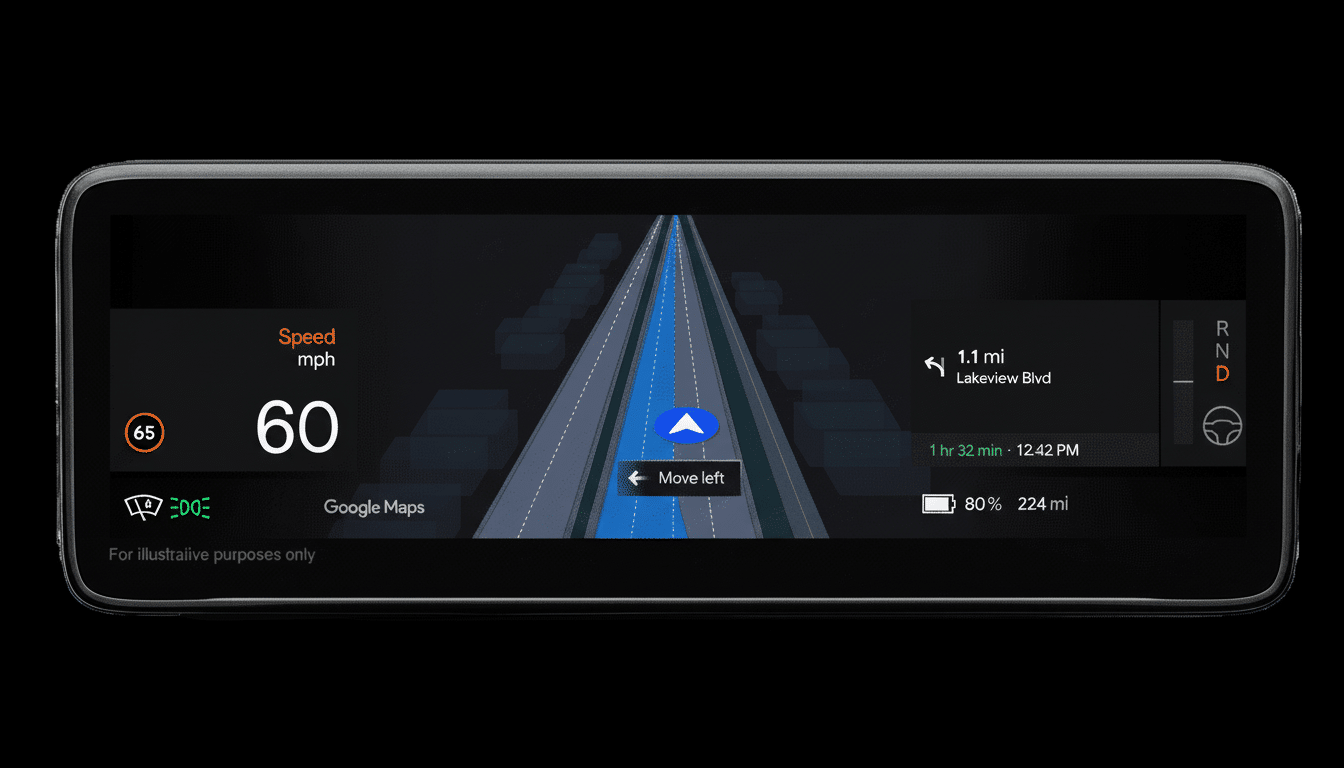Google is extending lane-precise smarts to its navigation stack, and promises not just turn-by-turn instructions indicating which lane should be taken but knowing when you’ve chosen the wrong one. The company also introduced a new live lane guidance feature, which takes advantage of the car’s front-facing camera to read your precise lane and give you a nudge to switch when a turn or an exit is coming up. It will first be available in Polestar 4 vehicles for sale in the U.S. and Sweden, starting with highways and a broader rollout to follow through other automaker partnerships.
How Live Lane Guidance Works in Google Maps
Old-fashioned “lane guidance” in Google Maps indicates the right path on screen. Live lane guidance takes all that to the next level by blending computer vision with map data — the system uses a vehicle’s forward camera feed to analyze lane markings, read them using AI and compares what it sees with your planned route. I’m rolling along in the center lane headed for a cloverleaf, but the exit is two lanes to my right — and there’s little traffic that needs navigating around me. Maps will warn you with on-screen cues and audio prompts before you go astray.

[The approach] mimics some components of advanced driver-assistance systems but remains strictly in the domain of navigation. Instead of driving the car, it begins to offer interactive coaching that’s actually timely and context-aware. And that distinction matters when it comes to adoption: drivers get lane-level clarity without the regulatory burden of hands-free driving features.
At launch, the feature is focusing on highways, where lane markings are generally clearer and the stakes for routing are higher — missing an exit or trying to cross multiple lanes at high speed can be a lot more dangerous than making a wrong turn in an urban area. As Google trains its models on more edge cases (think faded paint, construction zones, lane splits), support for other road types will come later.
Why It Matters for Normal Driving and Safety
Cameras facing both sides of the windshield, brakes gently applied, steady pace. At sprawling interchanges like Atlanta’s Spaghetti Junction or Los Angeles’ Four Level, a missed move could cost you several minutes and force an unexpected merge, just the sort of behavior safety researchers tag as risk-prone.
Groups like the Insurance Institute for Highway Safety have found that lane awareness systems are correlated with decreases in sideswipe and head-on injury crashes. If that timing helps drivers keep to the proper lane well before they need to, it might enhance those gains by curtailing last-second weaving and sudden cuts across traffic.
There’s also a scale story. Google Maps is used by well over a billion people every month. Even minor enhancements to lane discipline or exit accuracy, multiplied across that user base, can significantly decrease missed turns and wasted extra miles — and the associated frustration.
Rollout Begins with Polestar and Google Built-In
It arrives in the Polestar 4, a performance EV that runs Google built-in — the Mountain View giant’s homegrown infotainment suite built on Android Automotive. That tight integration provides Maps with a direct line to the car’s camera signals and its display surfaces, allowing for the real-time analysis and clear messaging lane-level prompts require.

Google says it plans to roll out the assistant to additional models “in partnership with key automakers.” Most likely it’s brands that already offer Google built-in, such as Volvo, Honda, Nissan and Ford. Just like other linked features, availability probably will vary depending on the quality of a vehicle’s cameras, its processing power and regional validation.
Limits and Open Questions About Live Lane Guidance
Computer vision depends on good lane markings and good light; sleet, glare or patchy paint can challenge the most sophisticated models. Highways are a reasonable place to start, but urban arterials with bus-only lanes, reversible lanes or temporary cones will test resilience. Until then, conservative behavior should be the order of the day as and when enough real-world data through testing in different scenarios has accumulated.
Privacy and data handling will certainly be closely monitored. Drivers will want clarity about what data from the camera is processed on their vehicle (if any) and that which goes to the cloud (if any), as well as how long it’s stored. Google has made on-device processing a centerpiece of automotive AI functions, and similar guardrails would provide reassurance here.
Super-duper lastly, this isn’t a driver-assistance system. It won’t drive itself, or change lanes; it will tell. Drivers are still in charge of watching the road and changing lanes safely. Seen as a co-pilot rather than a pilot, it has the potential to seriously reduce cognitive load in our efforts to guide ourselves down strange roads.
A New Layer in the Maps War: Camera-Fused Guidance
Apple Maps and Waze have evolved visual lane guidance. The camera-informed lane detection directly integrated into navigation is a significant step forward, though.
It’s a glimpse at where in-car mapping might be going: deeper sensor fusion, more proactive guidance and context that constantly adjusts, rather than depending entirely on static map tiles.
If Google follows through, the payoff will seem simple to drivers: less time missing exits and smoother transitions well in advance of a sneaky turn. The simplicity is built on top of complex AI, delicate human factors design and the slow but necessary work of validating each road type, region and vehicle. For the time being, Polestar drivers get their first taste — everyone else may not be too far behind.

